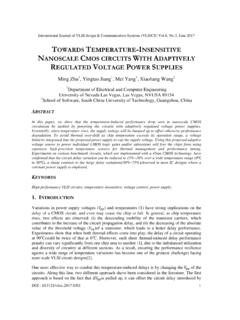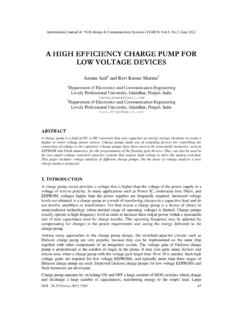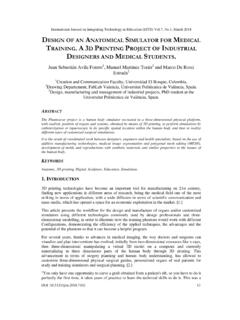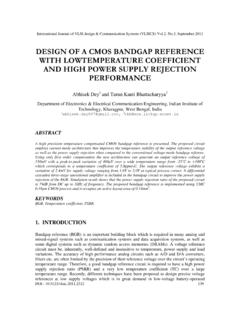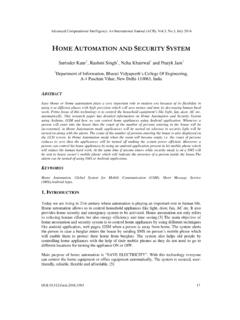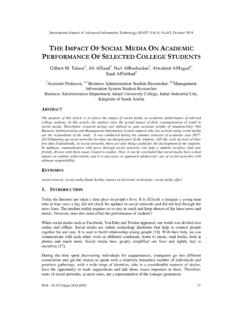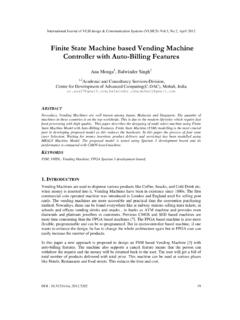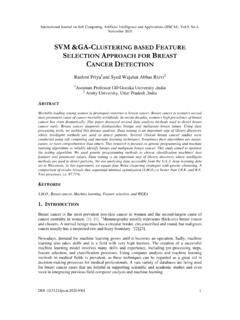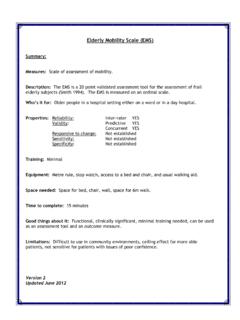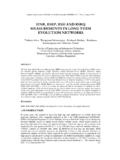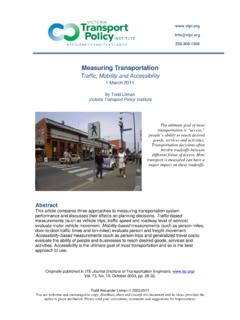Transcription of MOBILITY LOAD BALANCING BASED ADAPTIVE …
1 International Journal of Wireless & Mobile Networks (IJWMN) Vol. 8, No. 4, August 2016 DOI: 89 MOBILITY load BALANCING BASED ADAPTIVE HANDOVER IN DOWNLINK LTE SELF-ORGANIZING NETWORKS Hana Jouini1, Mohamed Escheikh1,Kamel Barkaoui2 and Tahar Ezzedine1 1 University of Tunis El Manar, Enit, Sys Com , 1002 Tunis, Tunisia 2 Cedric-Cnam : 2 Rue Cont 75003 Paris, France ABSTRACT This article investigates MOBILITY load BALANCING (MLB) algorithm implementation through network simulator (ns-3) in long term evolution (LTE) systems employing orthogonal frequency division multiple access (OFDMA) for downlink (DL) data transmission.
2 MLB is introduced by the third generation partnership project (3 GPP) as a key target of LTE self-organizing networks (SONs) [1]. Our contribution is twofold. First, we implemented elementary procedures (EPs) related to load management (LM) function of the X2-application protocol (X2AP) as specified in TS [2]. We particularly focused on EPs Resource Status Reporting Initiation Procedure and 'Resource Status Reporting Procedure . Second, we implemented a MLB BASED ADAPTIVE handover (HO) algorithm enabling to configure adaptively HO hysteresis threshold for each neighbouring cell, of an overloaded cell, according to its current load information.
3 Numerical results show how, through suitable simulation scenarios, MLB enables enhancing network performance in terms of overall throughput, packet loss ratio (PLR) and fairness without incurring HO overhead. KEYWORDS LTE, load management, X2AP, elementary procedure, MOBILITY load BALANCING 1. INTRODUCTION In recent years, wireless cellular networks' operators have experienced a spectacular growth in mobile data traffic. With the surging traffic demand, wireless cellular networks are becoming significantly more complex, causing higher operational costs.
4 In order to reduce these costs while optimizing network efficiency and service quality, the SON concept had been introduced in LTE systems. SON concept aims to reduce manual operations by integrating self-optimizing, self-healing and self-configuration features. MLB is one of the most important functionalities that belong to self-optimizing SON techniques. In wireless cellular networks, loads in different cells are frequently unequal. This leads to critical situation where hot spot cells ( overloaded cells) suffer from a high call blocking rate (CBR) and/or call dropping rate (CDR).
5 In contrast, a large part of resources in low-loaded cells remains in idle state causing resource wastes. Therefore, load imbalance between neighbouring cells seriously deteriorates network performance. In this regard MLB solutions are deployed to circumvent this problem and to enhance fairness, availability, scalability, user-experience and network utilization. International Journal of Wireless & Mobile Networks (IJWMN) Vol. 8, No. 4, August 2016 90 In literature several load BALANCING methods devoted to cellular networks have been proposed.
6 Authors in [3] formulate a multi-objective optimization problem using utility function jointly optimizing load BALANCING (LB) index and network average load for users with quality of service (QoS) requirements. They conclude that better values of LB index and network average load can be achieved when compared with other conventional methods. In [4, 5], authors investigate conflicting and stand-alone SON functions. They particularly focused on two SON functions namely MLB and handover optimization (HOO).
7 In this direction also and in order to optimize the same parameter values having conflicting goals at the same network element (NE), 3 GPP proposes an additional entity, usually called coordinator [21]. Alternatively, to reach the above purpose, authors in [4] propose a unified self-management mechanism for MLB and HOO BASED on fuzzy logic and reinforcement learning techniques. The objective behind is to reduce SON coordination entity's complexity. Authors in [5] propose an optimization technique of both MLB and HOO functions BASED on a weighted co-satisfaction factor (CSF).
8 Another practical solution for MLB is proposed in [6] and is BASED on HO margins' auto-tuning of each base station according to its load and the load of its neighbouring cells. Authors highlight through simulation analysis MLB impact on both call admission rate and user throughput. Z. Huang et al. propose in [7] a multi-traffic load balance algorithm (MTLB) to promote an efficient load balance. Yang et al. propose in [8] an auto-configuration technique of handover hysteresis threshold according to the load information of the current overloaded cell and its neighbours.
9 The proposed technique triggers the MLB procedure according to the load condition of a cell and significantly reduces CBR, HO dropping/blocking rate and ping-pong HO rate. However, the paper neglects the impact of the proposed mechanism on some key performance metrics such as the global throughput in the network and the LB index. The proposed model in the above paper is implemented using a formal description technique BASED on a specification and a description language (SDL).
10 Thereby algorithm efficiency in [8] needs to be improved for more realistic conditions and in this regard a more realistic implementation with respect to the 3 GPP specifications could be established. In this paper we propose a MLB algorithm implementation BASED on discrete-event network simulator ns-3 [17]. To that end two implementation steps are followed. In a first step two LM EPs of the of X2AP protocol namely 'Resource Status Reporting Initiation Procedure' and 'Resource Status Reporting Procedure' are implemented as specified in TS [2].
